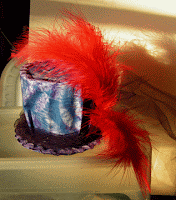This is a post from last year in December.
I love Christmas.
Such a joyous and fun time of year. And the wonderful decorations everywhere.
Are you looking
for a fairly simple project to make holiday decorations? Well, this one is just
that. It’s pretty simple and might be fun for the kids.
One of my
favorite projects that the disabled group did during the holidays one year was
to make cone trees. They covered the cones with felt or fabric and then glued
pasta to them. Some pasta was painted with acrylic paint, others, like the
farfalle (bow tie) was just glued on. (with a glue gun)
The three trees shown here were done in just a few hours
with my glue gun. The first one I did was covered with green fabric and then
tulle. I ran red and green ribbons down from the tip and then added small
rhinestones as accents. The gold garland is actually a Mardi Gras necklace that
I glued on.
 The second one is
the purple stretch velvet tree. I used an old necklace chain for the garland
and washers from the hardware store for the ornaments. The top is more washers
capped with a covered nut. Obviously I had Steampunk in mind when making this
one.
The second one is
the purple stretch velvet tree. I used an old necklace chain for the garland
and washers from the hardware store for the ornaments. The top is more washers
capped with a covered nut. Obviously I had Steampunk in mind when making this
one. The third tree
was covered with felt that was cut into pieces. It took almost two large
squares of felt and I started at the bottom and cut the upper layers smaller as
I went. The garland is from the mini Christmas tree decorations you can buy at
the craft store. The ornaments are glass pony beads. Once they were on I put
gold glitter glue into the centers to make them sparkle.
The third tree
was covered with felt that was cut into pieces. It took almost two large
squares of felt and I started at the bottom and cut the upper layers smaller as
I went. The garland is from the mini Christmas tree decorations you can buy at
the craft store. The ornaments are glass pony beads. Once they were on I put
gold glitter glue into the centers to make them sparkle. To make the
trees, I started with a piece of illustration board, cut to create a cone. Tape
helped me keep it in shape while I used the glue gun to set it. The tape can be
left on as an added support, or taken off once the glue sets.
To make the
trees, I started with a piece of illustration board, cut to create a cone. Tape
helped me keep it in shape while I used the glue gun to set it. The tape can be
left on as an added support, or taken off once the glue sets.
For the velvet
and striped trees, a piece of fabric was cut just a little larger than the tree
cone and one edge was turned and glued to create a nice finish. The unfinished
edge was glued first and then I worked my way around the cone. The bottom was
snipped to make gluing easier.
 The stars on the
top of the tall trees are polymer clay. The clay was rolled out to about a
quarter inch thickness and a star cookie cutter was used to cut the shapes.
Then a skewer was used to put the hole in the bottom. Both stars were dusted
with Ranger embossing powders for color and glitter. They were baked with the
skewers in place to prevent the holes from collapsing while hot. They were
glued on the trees with E6000 glue. I did put a chenille stem into the hole in
the top and glue it down, then left a piece sticking up to glue into the hole
in the bottom of the star. This helps to keep the star stable.
The stars on the
top of the tall trees are polymer clay. The clay was rolled out to about a
quarter inch thickness and a star cookie cutter was used to cut the shapes.
Then a skewer was used to put the hole in the bottom. Both stars were dusted
with Ranger embossing powders for color and glitter. They were baked with the
skewers in place to prevent the holes from collapsing while hot. They were
glued on the trees with E6000 glue. I did put a chenille stem into the hole in
the top and glue it down, then left a piece sticking up to glue into the hole
in the bottom of the star. This helps to keep the star stable.
Cone trees can be
any color, any fabric. You can decorate with whatever you want. You could cover
them with feathers, glitter, stars, pasta, or wrap chains all around. The
decoration is totally up to you.
This is a fun
project. You can decorate with one, three or a dozen. They could even be given
as gifts. Decorate your desk at work. Put a small one on the bathroom counter.
One for every room in the house.
If doing this one
with the kids, you may have to help with the hot glue gun. But they will love
making a tree for their room or to help decorate the house.
Let your
imagination go wild. And make it messy, of course.
Til next time. J
Terri
Supplies used in
this blog are available at www.Michaels.com, www.HobbyLobby.com, www.Joanns.com,
or your local craft supply store.


















































